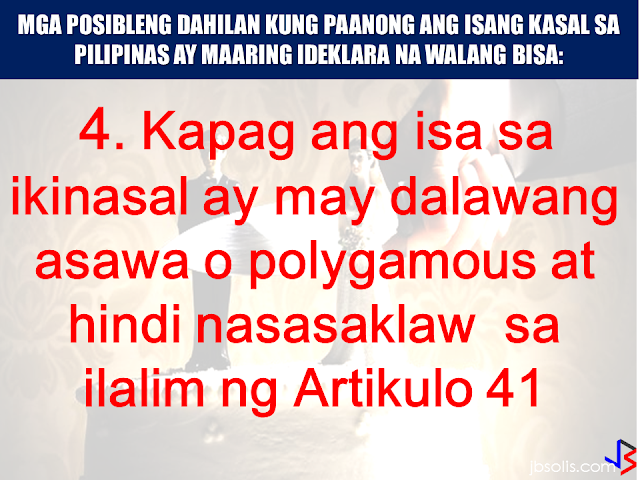Marriage is a union between two people in matrimony duly solemnized by a priest, a pastor, a minister a licensed representative of a congregation authorized to conduct such act or a judge/public official with authority to join together a couple in matrimony.
In such cases, a valid legal marriage can be difficult to annul and it has to go various legal process and a lot of penny to spend.
However, there are some circumstances that a marriage can be declared null and void.
Here are some grounds stated in Article 35 of Executive Order No. 209, otherwise known as the Family Code of the Philippines:
(1) When a marriage is contracted by any party below eighteen (18) years of age even with the consent of parents or guardians;
(2) When a marriage is solemnized by any person not legally authorized to perform marriages, unless such marriage was contracted with either or both parties believing in good faith that the solemnizing officer had the legal authority to do so;
(3) When a marriage is solemnized without license, except those covered under Title I, Chapter 2 of the Family Code;
Family Code of the Philippines
Title 1 Chapter 2. Marriages Exempted from License Requirement
Art. 27. In case either or both of the contracting parties are at the point of death, the marriage may be solemnized without necessity of a marriage license and shall remain valid even if the ailing party subsequently survives. (72a)
(4) When a marriage is bigamous or polygamous and not falling under Article 41;
(5) When a marriage is contracted through mistake of one contracting party as to the identity of the other
(6) A subsequent marriage which is void under Article 53.
Art. 53. Either of the former spouses may marry again after compliance with the requirements of the immediately preceding Article; otherwise, the subsequent marriage shall be null and void.
In such cases, a valid legal marriage can be difficult to annul and it has to go various legal process and a lot of penny to spend.
However, there are some circumstances that a marriage can be declared null and void.
Here are some grounds stated in Article 35 of Executive Order No. 209, otherwise known as the Family Code of the Philippines:
(1) When a marriage is contracted by any party below eighteen (18) years of age even with the consent of parents or guardians;
(2) When a marriage is solemnized by any person not legally authorized to perform marriages, unless such marriage was contracted with either or both parties believing in good faith that the solemnizing officer had the legal authority to do so;
(3) When a marriage is solemnized without license, except those covered under Title I, Chapter 2 of the Family Code;
Art. 27. In case either or both of the contracting parties are at the point of death, the marriage may be solemnized without necessity of a marriage license and shall remain valid even if the ailing party subsequently survives. (72a)
Art. 28. If the residence of either party is so located that there is no means of transportation to enable such party to appear personally before the local civil registrar, the marriage may be solemnized without necessity of a marriage license. (72a)
Art. 29. In the cases provided for in the two preceding articles, the solemnizing officer shall state in an affidavit executed before the local civil registrar or any other person legally authorized to administer oaths that the marriage was performed in articulo mortis or that the residence of either party, specifying the barrio or barangay, is so located that there is no means of transportation to enable such party to appear personally before the local civil registrar and that the officer took the necessary steps to ascertain the ages and relationship of the contracting parties and the absence of legal impediment to the marriage. (72a)
Art. 30. The original of the affidavit required in the last preceding article, together with the legible copy of the marriage contract, shall be sent by the person solemnizing the marriage to the local civil registrar of the municipality where it was performed within the period of thirty days after the performance of the marriage. (75a)
Art. 31. A marriage in articulo mortis between passengers or crew members may also be solemnized by a ship captain or by an airplane pilot not only while the ship is at sea or the plane is in flight, but also during stopovers at ports of call. (74a)
Art. 32. A military commander of a unit, who is a commissioned officer, shall likewise have authority to solemnize marriages in articulo mortis between persons within the zone of military operation, whether members of the armed forces or civilians. (74a)
Art. 33. Marriages among Muslims or among members of the ethnic cultural communities may be performed validly without the necessity of marriage license, provided they are solemnized in accordance with their customs, rites or practices. (78a)
Art. 34. No license shall be necessary for the marriage of a man and a woman who have lived together as husband and wife for at least five years and without any legal impediment to marry each other. The contracting parties shall state the foregoing facts in an affidavit before any person authorized by law to administer oaths. The solemnizing officer shall also state under oath that he ascertained the qualifications of the contracting parties are found no legal impediment to the marriage. (76a)
(4) When a marriage is bigamous or polygamous and not falling under Article 41;
Art. 41. A marriage contracted by any person during subsistence of a previous marriage shall be null and void, unless before the celebration of the subsequent marriage, the prior spouse had been absent for four consecutive years and the spouse present has a well-founded belief that the absent spouse was already dead. In case of disappearance where there is danger of death under the circumstances set forth in the provisions of Article 391 of the Civil Code, an absence of only two years shall be sufficient.
For the purpose of contracting the subsequent marriage under the preceding paragraph the spouse present must institute a summary proceeding as provided in this Code for the declaration of presumptive death of the absentee, without prejudice to the effect of reappearance of the absent spouse. (83a)
(5) When a marriage is contracted through mistake of one contracting party as to the identity of the other
(6) A subsequent marriage which is void under Article 53.
Art. 53. Either of the former spouses may marry again after compliance with the requirements of the immediately preceding Article; otherwise, the subsequent marriage shall be null and void.
(7) A marriage between the following persons may also be declared null and void, whether their relationship be legitimate or illegitimate:
(1) Between ascendants and descendants of any degree; and
2) Between brothers and sisters, whether of the full or half blood (Article 37, Family Code of the Philippines).
(1) Between ascendants and descendants of any degree; and
2) Between brothers and sisters, whether of the full or half blood (Article 37, Family Code of the Philippines).
Art. 37. Marriages between the following are incestuous and void from the beginning, whether relationship between the parties be legitimate or illegitimate:
- (1) Between ascendants and descendants of any degree; and
(2) Between brothers and sisters, whether of the full or half blood. (81a)
Some other things that may deem your marriage absolutely null and void for reasons of public policy when it is contracted between the following persons as stated in Article 38 of the Family Code of the Philippines :
(1) Collateral blood relatives whether legitimate or illegitimate, up to the fourth civil degree;
(2) Step-parents and step-children;
(3) Parents-in-law and children-in-law;
(4) Adopting parent and the adopted child;
(5) Surviving spouse of the adopting parent and the adopted child; (6) Surviving spouse of the adopted child and the adopter;
(7) An adopted child and a legitimate child of the adopter;
(8) Adopted children of the same adopter; and
(9) Parties where one, with the intention to marry the other, killed that other person’s spouse, or his or her own spouse .
(1) Collateral blood relatives whether legitimate or illegitimate, up to the fourth civil degree;
(2) Step-parents and step-children;
(3) Parents-in-law and children-in-law;
(4) Adopting parent and the adopted child;
(5) Surviving spouse of the adopting parent and the adopted child; (6) Surviving spouse of the adopted child and the adopter;
(7) An adopted child and a legitimate child of the adopter;
(8) Adopted children of the same adopter; and
(9) Parties where one, with the intention to marry the other, killed that other person’s spouse, or his or her own spouse .
SEARCH JBSOLIS









